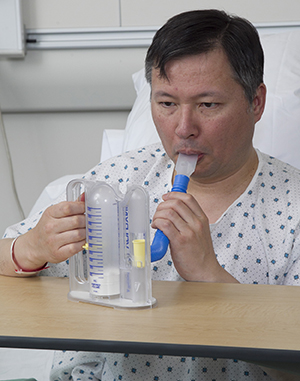An incentive spirometer is a handheld device that helps you do deep breathing exercises after surgery. It also helps lower the risk of breathing problems if you have a lung disease or condition. These exercises expand your lungs, aid in circulation, and may help prevent pneumonia. Deep breathing exercises also help you breathe better and improve lung function by:
-
Keeping your lungs clear.
-
Making your breathing muscles stronger.
-
Helping prevent respiratory complications or problems.
The incentive spirometer gives you a way to take an active part in your recovery. A nurse or respiratory therapist will teach you breathing exercises. To do these exercises, you will breathe in through your mouth and not your nose. The incentive spirometer only works correctly if you breathe in through your mouth.
Your health care provider or their staff will tell you how to use the device, your targeted volume(s), and provide other helpful tips to prevent complications (such as pain, dizziness, feeling lightheaded) when blowing in the incentive spirometer.
Steps to clear lungs
Step 1. Exhale normally. Then, inhale normally.
-
Relax and breathe out.
Step 2. Place your lips tightly around the mouthpiece.
-
Make sure the device is upright and not tilted.
-
Sit up and breathe out (exhale) fully.
-
Tightly seal your lips around the mouthpiece.
Step 3. Inhale as much air as you can through the mouthpiece. Don't breathe through your nose.
-
Breathe in (inhale) slowly and deeply.
-
Hold your breath long enough to keep the balls, piston, or disk raised for at least
3 to5 seconds, or as instructed by your health care provider. -
Exhale slowly to allow the balls, piston, or disk to fall before repeating.
Note: Some spirometers have an indicator to let you know that you are breathing in too fast. If the indicator goes off, breathe in more slowly.
Step 4. Repeat the exercise regularly.
-
Do sets of 10 exercises every hour while you're awake, or as instructed by your health care provider. Don't do more than 30 breaths in each set.
-
If you were taught deep breathing and coughing exercises, do them regularly as instructed by your provider, nurse, or respiratory therapist.
Follow-up care
Make a follow-up appointment as directed by your health care provider. Also, follow up with your provider as advised if your symptoms don't improve or continue to get worse.
When to contact your doctor
Contact your health care provider right away if you have:
-
A fever 100.4° (38°C) or higher, or as advised by your provider.
-
Brownish, bloody, or smelly sputum (phlegm that you cough up).
Call 911
Call
-
Shortness of breath that doesn't get better after taking your medicine
-
Cool, moist, pale, or blue skin
-
Trouble breathing or swallowing, wheezing
-
Fainting or loss of consciousness
-
Feeling of dizziness or weakness, or a sudden drop in blood pressure
-
Feeling very ill
-
Lightheadedness
-
Chest pain or rapid heart rate


